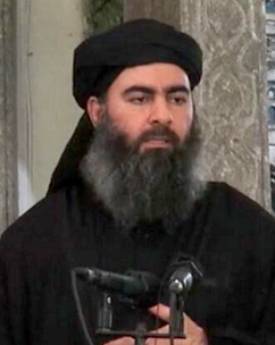 [WASHINGTONPOST] His self-declared caliphate was in ruins when His Supreme Immensity, Caliph of the Faithful and Galactic Overlord, Abu Bakr al-Baghdadi
[WASHINGTONPOST] His self-declared caliphate was in ruins when His Supreme Immensity, Caliph of the Faithful and Galactic Overlord, Abu Bakr al-Baghdadi...the head of ISIS, or what remains of it, and a veteran of the Abu Graib jailhouse. Looks like a new messiah to bajillions of Moslems, like just another dead-eyed mass murder to the rest of us. So far he has been killed at least four times, though not yet by a stake through the heart...
summoned some of his top aides to a meeting in eastern Syria last year. The Islamic State
...formerly ISIS or ISIL, depending on your preference. Before that al-Qaeda in Iraq, as shaped by Abu Musab Zarqawi. They're very devout, committing every atrocity they can find in the Koran and inventing a few more. They fling
Allaharound with every other sentence, but to hear the pols talk they're not
reallyMoslems....
’s capital in Iraq had already fallen, and its Syrian headquarters was under siege.
Yet the terrorist leader had something else on his mind: schoolchildren.
 The gathering near the city of Deir al-Zour was called by Baghdadi personally to discuss rewriting the terrorist group’s educational curriculum, according to an Islamic State official who was jugged
The gathering near the city of Deir al-Zour was called by Baghdadi personally to discuss rewriting the terrorist group’s educational curriculum, according to an Islamic State official who was juggedInto the paddy wagon wit' yez!
in a joint operation by
"Several top leaders were present, as well as the curricula committee, which I headed," the captured officer, known as Abu Zaid al-Iraqi, said in a videotaped statement aired on Iraqi television.
The meeting, said to have occurred in mid-2017, was the third convening of a committee that had been a pet project of the man at the top, having been "established by caliph Abu Bakr al-Baghdadi," the officer said.
The incident provides a rare glimpse into the secluded life of the Islamic State’s leader, a man who has allowed himself to be photographed only once, in July 2014, and has spoken publicly only a handful of times since then. His prolonged absences have given wings to countless false reports portraying Baghdadi as either dead, or gravely maimed and incapacitated.
Despite such rumors, U.S. counterterrorism officials are convinced that Baghdadi is alive and is helping direct long-term strategy for the dwindling numbers of Islamic State fighters defending the group’s remaining strongholds in eastern Syria. The U.S. view is supported by intelligence intercepts and detainee interrogations, as well as writings and statements by operatives within the terrorist group’s network.
[’We are in your home’: After losses, ISIS steps up campaign to inspire attacks]
The evidence, while spotty and difficult to confirm, depicts a leader who has opted to make himself invisible, even within his organization ‐ a decision that has drawn complaints from followers and arguably undercuts his ability to rally his beleaguered forces, terrorism experts say.
But the intercepts and reports also suggest that Baghdadi has shifted his attention in recent months to crafting an ideological framework that will survive the physical destruction of the caliphate in Iraq and Syria. In addition to his effort to revamp the group’s school curriculum, Baghdadi appears to have been behind a series of missives in recent months that sought to settle ideological disputes between factions of Islamic State fighters.
Viewed together, such actions convey the impression of a disciplined retreat, with Baghdadi helping manage preparations for a shift from caliphate to underground insurgency and international terrorist movement, current and former U.S. officials said.
"Even as they were losing djinn-infested Mosul
... the home of a particularly ferocious and hairy djinn...
and Raqqa, we were seeing indications that they were planning to operate anew, as a clandestine organization," said Nicholas Rasmussen, who served as director of the National Counterterrorism Center before stepping down in December. "As they were being driven out of these places, they were leaving behind a kind of cell structure."